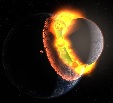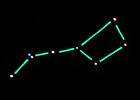|
Work progress - 0.9.8.1
|
|
| parameciumkid | Date: Thursday, 03.11.2016, 22:44 | Message # 256 |
 Explorer
Group: Users
 United States
United States
Messages: 277
Status: Offline
| I have a hunch that, both in real life and in SE, planetary surface temperatures are contingent both on the sun's temperature and luminosity. Note for instance that a planet orbiting a red giant will be much hotter than one orbiting a main-sequence star of the same mass.
Intel HD Graphics 4000 ;P
|
| |
| |
| Alek | Date: Thursday, 03.11.2016, 22:50 | Message # 257 |
 Pioneer
Group: Users
 United States
United States
Messages: 326
Status: Offline
| Quote parameciumkid (  ) Note for instance that a planet orbiting a red giant will be much hotter than one orbiting a main-sequence star of the same mass.
But this is due to the stars luminosity, not temperature.
Living among the stars, I find my way. I grow in strength through knowledge of the space I occupy, until I become the ruler of my own interstellar empire of sorts. Though The world was made for the day, I was made for the night, and thus, the universe itself is within my destiny.
|
| |
| |
| Hornblower | Date: Thursday, 03.11.2016, 22:55 | Message # 258 |
 World Builder
Group: Users
 United States
United States
Messages: 714
Status: Offline
| Logically, it would make sense for luminosity to have a much greater impact on a planet's temperature than the star's temperature because heat doesn't have a median to travel through in space. The only heat from a star that would affect a planet is the solar wind, and that's only a little bit of energy as far as heating planets goes.
|
| |
| |
| Fireinthehole | Date: Friday, 04.11.2016, 10:05 | Message # 259 |
 Pioneer
Group: Translators
 Sweden
Sweden
Messages: 356
Status: Offline
| About the volumetric nebulae and galaxies, do you plan to make the models procedurallly generated in the next version?
Love SpaceEngine!
|
| |
| |
| xbrain130 | Date: Friday, 04.11.2016, 10:40 | Message # 260 |
 Observer
Group: Newbies
 Pirate
Pirate
Messages: 6
Status: Offline
| Quote parameciumkid (  ) Note for instance that a planet orbiting a red giant will be much hotter than one orbiting a main-sequence star of the same mass.
I think that must have something to do with the size, because the formula I mentioned also needs the star's diameter.
And even if logically luminosity is what would likely influence a planet temperature, that must be the bolometric temperature, but as I already pointed out, SpaceEngine correctly calculates only the visual one, therefore rendering planets are colder than they actually are, especially red dwarfs'.
I think it's for this reason that temperature is used, because it can be determined with a greater precision than absolute bolometric magnitude, which can be extrapolated from mass and temperature itself.
|
| |
| |
| cirax | Date: Friday, 04.11.2016, 19:46 | Message # 261 |
 Astronaut
Group: Users
 Spain
Spain
Messages: 43
Status: Offline
| I was about to continue here the discussion of the temperature problem for red dwarfs but as long I was thinking about some time ago I presented my conclusions in this thread, maybe a better place to continue with it.
My work for SE: Click here
Textures for Venus surface in color and the moons of Saturn, Uranus and Neptune.
Catalogs of binary stars, brown dwarfs, black holes and neutron stars.
Proxima b (3 versions).
|
| |
| |
| Hornblower | Date: Friday, 04.11.2016, 22:23 | Message # 262 |
 World Builder
Group: Users
 United States
United States
Messages: 714
Status: Offline
| Just had a thought! If Duke's shaders are already programmed to expand, then I have a suggestion. Would it be too hard to implement another type of nebula? Duke's shaders would be perfect for light echoes! They would be smooth expand much faster and live for a much shorter time than normal nebula objects.
|
| |
| |
| arbelrocks | Date: Tuesday, 15.11.2016, 13:11 | Message # 263 |
 Space Tourist
Group: Users
 Pirate
Pirate
Messages: 24
Status: Offline
| Any plans for recording in MP4?
|
| |
| |
| Nsaabahnur | Date: Thursday, 17.11.2016, 00:52 | Message # 264 |
 Observer
Group: Newbies
 Romania
Romania
Messages: 4
Status: Offline
| Based on the recent data regarding the size of the universe being 10x times larger than previous estimates, will future versions of Space Engine reflect this? Also recent data indicates that the Milky Way is 2 or 3 times bigger that previously thought.
Edited by Nsaabahnur - Thursday, 17.11.2016, 00:54 |
| |
| |
| DoctorOfSpace | Date: Thursday, 17.11.2016, 01:01 | Message # 265 |
 Galaxy Architect
Group: Global Moderators
 Pirate
Pirate
Messages: 3600
Status: Offline
| Quote Nsaabahnur (  ) will future versions of Space Engine reflect this?
Quote SpaceEngineer (  ) Anyway, I should note: as long as SE is a scientifically accurate Universe simulator, then one day it will implement ALL space objects and phenomenon that are known to modern astronomy (if this would be possible to implement on the personal computers). So you may not bother yourself with questions like "will SE one day have meteor rain implemented". I guarantee that it WILL.
Intel Core i7-5820K 4.2GHz 6-Core Processor
G.Skill Ripjaws V Series 32GB (4 x 8GB) DDR4-2400 Memory
EVGA GTX 980 Ti SC 6GB
|
| |
| |
| parameciumkid | Date: Thursday, 17.11.2016, 05:24 | Message # 266 |
 Explorer
Group: Users
 United States
United States
Messages: 277
Status: Offline
| Is this in reference to the recent announcement that there may be several times the estimated number of galaxies in the universe, or something new about the physical volume of the visible universe being larger?
Intel HD Graphics 4000 ;P
|
| |
| |
| Nsaabahnur | Date: Thursday, 17.11.2016, 11:38 | Message # 267 |
 Observer
Group: Newbies
 Romania
Romania
Messages: 4
Status: Offline
| It's regarding the new estimates of the number of galaxies in the observable universe.
|
| |
| |
| arturuniverse | Date: Saturday, 19.11.2016, 21:30 | Message # 268 |
 Astronaut
Group: Users
 Pirate
Pirate
Messages: 60
Status: Offline
| Hey SpaceEngineer (Or SE team), could you guys post some development videos on the main youtube channel? Solaris recently posted and I remembered that it would be cool if we see a little bit of what's going on, since we aren't from the dev or have the steam keys.
We all have an end, but we choose and create that end by ourselves.
|
| |
| |
| chessman2005 | Date: Wednesday, 23.11.2016, 09:12 | Message # 269 |
|
Observer
Group: Newbies
 Pirate
Pirate
Messages: 3
Status: Offline
| Soooo when could one expect this VR update to be out? Also after Google Earth VR consider doing this smaller view solution for motion sickness it works really well in Google Earth VR and Eagle's Flight.
|
| |
| |
| Inarius | Date: Wednesday, 23.11.2016, 14:20 | Message # 270 |
 Explorer
Group: Local Moderators
 France
France
Messages: 237
Status: Offline
| Unless I've missed something, it's been 1 month since SE last posted something about SE development.
Every year, we have a nice release around the last days of december, I hope this year we will have one, too  (even if I don't really know what would be in it !) (even if I don't really know what would be in it !)
My question is : will the next work progress information will be posted here, or on the new website ?
|
| |
| |